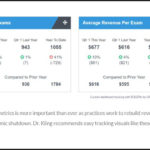By Michael Kling, OD
July 15, 2020
Practice closures due to the coronavirus wreaked havoc on all of our practices. One of the keys to a strong recovery will be careful tracking of practice metrics.
Here is my practice’s approach to ensuring our most important indicators for success are trending in the right direction.
Expect Short-Term Metric Anomalies
Practice metrics during the shutdown are likely to be a surprise–either higher or lower than you expected. For example, in my practice, revenue per exam has historically be around $500. In March, that number strangely jumped to $800. After closer analysis, it became obvious that the anomaly occurred due to the delay in receivables from our February business, combined with a reduction in number of exams we performed in March. That led to a high amount of revenues flowing into the practice in March relative to the few patients seen.
Cost of Goods (COGs) is another example of a metric that can be misleading for the months of the shutdown if looked at out of context. COGs were low during the shutdown in my practice because we stopped paying bills. Those bills are now due, and we are currently working to pay them off. This makes it look like our COGs jumped drastically after we reopened, but in actuality, the “jump” is a result of catching up on bill payment.
Resources to Help You Track Metrics
Identify Key Metrics & Watch How They’re Trending
Rather than trying to track every number in your practice, decide which are the most important indicators of practice financial health. In my practice’s case, we track 12 key metrics including exam volume, revenue-per-exam, revenue per OD hour, exam volume per OD, frame and lens capture rate per OD, AR capture rate per optician and contact lens revenue per contact lens patient, among others.
I color-code metrics so that metrics that are trending down compared to the previous month are colored red while those trending even or up are colored green. That way I can quickly glance at our metrics report and know the areas where more work may be needed. If your practice is looking for automated metrics-tracking technology, dashboard management systems, such as EDGEPro, offer this kind of color-coding.
Set Goals to Getting Back to Pre-Shutdown Metrics
My practice is building a 90-day recovery plan to get our metrics back to where they were prior to the shutdown. Getting back to our normal numbers has meant making adjustments, including my practice partner and I reducing payment of our own salary from the owner’s compensation account we set up. Following a Profit First model, we put aside money each month for owner compensation. During the shutdown, we allowed that money to accumulate.
Similarly, our staff incentive system, which usually pays incentives monthly, or quarterly, depending on cash flow, needed to be put on hold for our 27 employees. The first two months of 2020 had been strong for us, and we had been planning to distribute a generous bonus, but when the shutdown hit, we knew we would need to hold back those funds to aid practice survival.
Other Pieces to Explore
My partner and I plan to begin paying ourselves a salary again in July, and have already begun paying the bonuses our staff has earned this year.
Learn From Positive & Negative Metrics Trends
Rather than show my staff results for all of the metrics I track, I point out the metrics trends that are either strikingly good or strikingly worrisome. If good, I note the numbers so my staff knows to keep up the good work, and find ways to do more of the same. If worrisome, such as a falling eyewear capture rate, I talk about, and ask for discussion around, what the cause might be.
It’s easy to overwhelm your team by offering too much information. The smart way to use metrics is to use them to alert you of trends that could indicate a need to change the way you are operating. I have been able to successfully do this over the years with my team. We are leveraging this process now to make sure we are heading in the right direction in our practice recovery.
 Michael Kling, OD, is the president of Impact Leadership and the founder and CEO of Invision Optometry, a Vision Source practice in San Diego, Calif. To contact him: dr.kling@invisioncare.com
Michael Kling, OD, is the president of Impact Leadership and the founder and CEO of Invision Optometry, a Vision Source practice in San Diego, Calif. To contact him: dr.kling@invisioncare.com



























